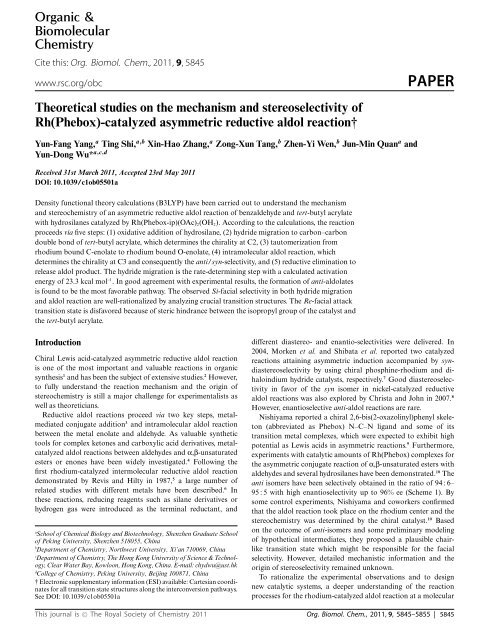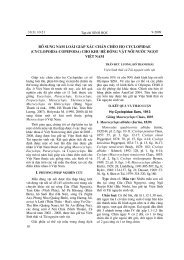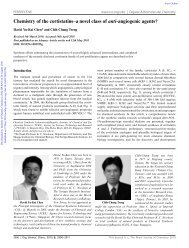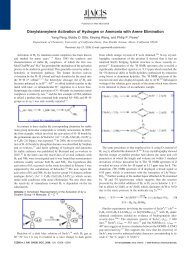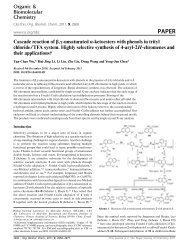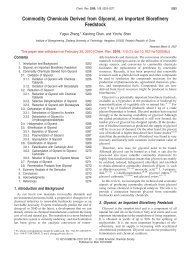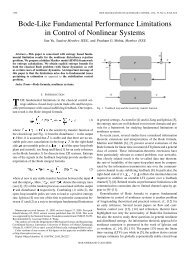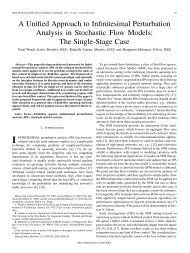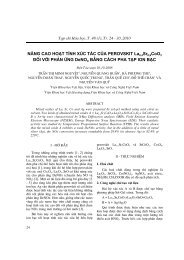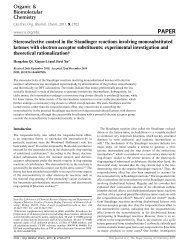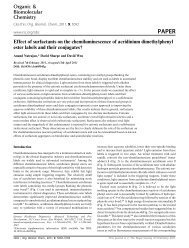catalyzed asymmetric reductive aldol reaction
catalyzed asymmetric reductive aldol reaction
catalyzed asymmetric reductive aldol reaction
You also want an ePaper? Increase the reach of your titles
YUMPU automatically turns print PDFs into web optimized ePapers that Google loves.
Organic &<br />
Biomolecular<br />
Chemistry<br />
Cite this: Org. Biomol. Chem., 2011, 9, 5845<br />
www.rsc.org/obc PAPER<br />
Theoretical studies on the mechanism and stereoselectivity of<br />
Rh(Phebox)-<strong>catalyzed</strong> <strong>asymmetric</strong> <strong>reductive</strong> <strong>aldol</strong> <strong>reaction</strong>†<br />
Yun-Fang Yang, a Ting Shi, a,b Xin-Hao Zhang, a Zong-Xun Tang, b Zhen-Yi Wen, b Jun-Min Quan a and<br />
Yun-Dong Wu* a,c,d<br />
Received 31st March 2011, Accepted 23rd May 2011<br />
DOI: 10.1039/c1ob05501a<br />
Density functional theory calculations (B3LYP) have been carried out to understand the mechanism<br />
and stereochemistry of an <strong>asymmetric</strong> <strong>reductive</strong> <strong>aldol</strong> <strong>reaction</strong> of benzaldehyde and tert-butyl acrylate<br />
with hydrosilanes <strong>catalyzed</strong> by Rh(Phebox-ip)(OAc) 2(OH 2). According to the calculations, the <strong>reaction</strong><br />
proceeds via five steps: (1) oxidative addition of hydrosilane, (2) hydride migration to carbon–carbon<br />
double bond of tert-butyl acrylate, which determines the chirality at C2, (3) tautomerization from<br />
rhodium bound C-enolate to rhodium bound O-enolate, (4) intramolecular <strong>aldol</strong> <strong>reaction</strong>, which<br />
determines the chirality at C3 and consequently the anti/syn-selectivity, and (5) <strong>reductive</strong> elimination to<br />
release <strong>aldol</strong> product. The hydride migration is the rate-determining step with a calculated activation<br />
energy of 23.3 kcal mol -1 . In good agreement with experimental results, the formation of anti-<strong>aldol</strong>ates<br />
is found to be the most favorable pathway. The observed Si-facial selectivity in both hydride migration<br />
and <strong>aldol</strong> <strong>reaction</strong> are well-rationalized by analyzing crucial transition structures. The Re-facial attack<br />
transition state is disfavored because of steric hindrance between the isopropyl group of the catalyst and<br />
the tert-butyl acrylate.<br />
Introduction<br />
Chiral Lewis acid-<strong>catalyzed</strong> <strong>asymmetric</strong> <strong>reductive</strong> <strong>aldol</strong> <strong>reaction</strong><br />
is one of the most important and valuable <strong>reaction</strong>s in organic<br />
synthesis 1 and has been the subject of extensive studies. 2 However,<br />
to fully understand the <strong>reaction</strong> mechanism and the origin of<br />
stereochemistry is still a major challenge for experimentalists as<br />
well as theoreticians.<br />
Reductive <strong>aldol</strong> <strong>reaction</strong>s proceed via two key steps, metalmediated<br />
conjugate addition 3 and intramolecular <strong>aldol</strong> <strong>reaction</strong><br />
between the metal enolate and aldehyde. As valuable synthetic<br />
tools for complex ketones and carboxylic acid derivatives, metal<strong>catalyzed</strong><br />
<strong>aldol</strong> <strong>reaction</strong>s between aldehydes and a,b-unsaturated<br />
esters or enones have been widely investigated. 4 Following the<br />
first rhodium-<strong>catalyzed</strong> intermolecular <strong>reductive</strong> <strong>aldol</strong> <strong>reaction</strong><br />
demonstrated by Revis and Hilty in 1987, 5 a large number of<br />
related studies with different metals have been described. 6 In<br />
these <strong>reaction</strong>s, reducing reagents such as silane derivatives or<br />
hydrogen gas were introduced as the terminal reductant, and<br />
a School of Chemical Biology and Biotechnology, Shenzhen Graduate School<br />
of Peking University, Shenzhen 518055, China<br />
b Department of Chemistry, Northwest University, Xi’an 710069, China<br />
c Department of Chemistry, The Hong Kong University of Science & Technology,<br />
Clear Water Bay, Kowloon, Hong Kong, China. E-mail: chydwu@ust.hk<br />
d College of Chemistry, Peking University, Beijing 100871, China<br />
† Electronic supplementary information (ESI) available: Cartesian coordinates<br />
for all transition state structures along the interconversion pathways.<br />
See DOI: 10.1039/c1ob05501a<br />
different diastereo- and enantio-selectivities were delivered. In<br />
2004, Morken et al. and Shibata et al. reported two <strong>catalyzed</strong><br />
<strong>reaction</strong>s attaining <strong>asymmetric</strong> induction accompanied by syndiastereoselectivity<br />
by using chiral phosphine-rhodium and dihaloindium<br />
hydride catalysts, respectively. 7 Good diastereoselectivity<br />
in favor of the syn isomer in nickel-<strong>catalyzed</strong> <strong>reductive</strong><br />
<strong>aldol</strong> <strong>reaction</strong>s was also explored by Christa and John in 2007. 8<br />
However, enantioselective anti-<strong>aldol</strong> <strong>reaction</strong>s are rare.<br />
Nishiyama reported a chiral 2,6-bis(2-oxazolinyl)phenyl skeleton<br />
(abbreviated as Phebox) N–C–N ligand and some of its<br />
transition metal complexes, which were expected to exhibit high<br />
potential as Lewis acids in <strong>asymmetric</strong> <strong>reaction</strong>s. 9 Furthermore,<br />
experiments with catalytic amounts of Rh(Phebox) complexes for<br />
the <strong>asymmetric</strong> conjugate <strong>reaction</strong> of a,b-unsaturated esters with<br />
aldehydes and several hydrosilanes have been demonstrated. 10 The<br />
anti isomers have been selectively obtained in the ratio of 94 : 6–<br />
95 : 5 with high enantioselectivity up to 96% ee (Scheme 1). By<br />
some control experiments, Nishiyama and coworkers confirmed<br />
that the <strong>aldol</strong> <strong>reaction</strong> took place on the rhodium center and the<br />
stereochemistry was determined by the chiral catalyst. 10 Based<br />
on the outcome of anti-isomers and some preliminary modeling<br />
of hypothetical intermediates, they proposed a plausible chairlike<br />
transition state which might be responsible for the facial<br />
selectivity. However, detailed mechanistic information and the<br />
origin of stereoselectivity remained unknown.<br />
To rationalize the experimental observations and to design<br />
new catalytic systems, a deeper understanding of the <strong>reaction</strong><br />
processes for the rhodium-<strong>catalyzed</strong> <strong>aldol</strong> <strong>reaction</strong> at a molecular<br />
This journal is © The Royal Society of Chemistry 2011 Org. Biomol. Chem., 2011, 9, 5845–5855 | 5845
Scheme 1 Asymmetric <strong>reductive</strong> <strong>aldol</strong> <strong>reaction</strong> of tert-butyl acrylate and benzaldehyde with Rh(Phebox) catalysts.<br />
level is necessary, for which the present computational chemistry<br />
is well-suited. 11 In this paper we aim to address the following<br />
questions: (1) what is the detailed mechanism, i.e. elementary steps<br />
of favorable pathways, of the Rh(Phebox-ip)-<strong>catalyzed</strong> <strong>asymmetric</strong><br />
<strong>reductive</strong> <strong>aldol</strong> <strong>reaction</strong>? (2) what is the origin of stereoselectivity,<br />
i.e. regio- and diastereo-selectivity?<br />
The computational method<br />
All calculations have been carried out with the Gaussian 03<br />
program. 12 Geometries of all the stationary points were fully<br />
optimized by the B3LYP method, 13 and the nature of these<br />
structures was verified by harmonic vibrational frequency analysis.<br />
Minima were characterized by all real frequencies, while transition<br />
states have one and only one imaginary frequency. In these<br />
calculations, the 6-31G(d) basis set 14 was used for H, C, N<br />
and O atoms, while the Lanl2dz basis set 15 was used for Si<br />
and Rh atoms. Intrinsic <strong>reaction</strong> coordinates (IRC) 16 calculations<br />
were performed to confirm that transition state structures indeed<br />
connect two relevant minima. To evaluate solvent effect, singlepoint<br />
energy calculations with the self-consistent <strong>reaction</strong> field<br />
(SCRF) calculation based on the polarizable continuum model<br />
(PCM, 17 e = 2.247 for toluene, which is used as the solvent in<br />
experiments) were carried out at the same level as the one used for<br />
geometry optimization.<br />
Results and discussion<br />
1 Structure analysis of the Rh(Phebox-ip)(OAc) 2(OH 2) complex<br />
The molecular structure of the catalyst (Rh(Phebox-ip)(OAc) 2-<br />
(OH 2)) was analyzed by X-ray crystallography (CCDC-248010)<br />
and showed a C 2 symmetric form. 18 Our calculation on the<br />
Table 1 Selected bond lengths and bond angle of the catalyst Rh(Phebox-ip)(OAc) 2(OH 2)<br />
structure of the catalyst gives rather reliable values compared<br />
to the bond lengths and bond angle of the X-ray structure<br />
(Table 1). As shown in Fig. 1, the catalyst Rh(Pheboxip)(OAc)<br />
2(OH 2) is a 6-coordinated complex with an N–C–N<br />
pincer ligand, two axial AcO ligands and a neutral water ligand.<br />
Hydrogen-bonding was found between the metal-bound water<br />
and the axial AcO ligands. Once the catalyst goes into the<br />
catalytic cycle, it is a necessity that the water ligand dissociates<br />
to afford vacant sites which can recruit substrates. It is proposed<br />
by Nishiyama that the starting Rh III complex can be reduced<br />
by an excess of hydrosilane to form Rh I species, which reacts<br />
with hydrosilane again to give an H–Rh III –Si active species as the<br />
catalyst. 10 So the catalyst (Rh III (Phebox-ip)(OAc) 2(OH 2)) can be<br />
regarded as a precatalyst and the (Rh I (Phebox-ip)) complex is<br />
considered as the active catalyst.<br />
Fig. 1 Structure of the catalyst Rh(Phebox-ip)(OAc) 2(OH 2).<br />
Bond length [A˚ ] Bond angle [ ◦ ]<br />
Rh–C Rh–N 1 Rh–N 2 Rh–O 1 Rh–O 2 Rh–O 4 O 1 –O 3 O 1 –O 5 N 1 –Rh–N 2<br />
Crystal<br />
Structure<br />
1.924 2.058 2.088 2.232 2.026 2.047 2.673 2.601 158.358<br />
Calculation 1.945 2.098 2.125 2.259 2.075 2.080 2.689 2.644 157.955<br />
5846 | Org. Biomol. Chem., 2011, 9, 5845–5855 This journal is © The Royal Society of Chemistry 2011
2 Calculations of model species<br />
Scheme 2 Si–H oxidative addition and hydride/silyl migration with simplified model system.<br />
Based on the experimental findings, Nishiyama and co-workers<br />
proposed the <strong>reaction</strong> sequence as: the starting Rh III (Phebox)<br />
reacts with hydrosilane via aRh I complex to give a Rh III hydride;<br />
the hydride then migrates into a,b-unsaturated ester to produce<br />
Rh III enolate, which couples with benzaldehyde; the final <strong>aldol</strong><br />
product is released by a <strong>reductive</strong> elimination step. However, for<br />
such a complicated <strong>reaction</strong> which involves four components, i.e.<br />
Rh catalyst, hydrosilane, a,b-unsaturated ester and aldehyde, what<br />
is the <strong>reaction</strong> process in detail? Is there any other alternative<br />
pathway? It is more reasonable to use a simplified model for a<br />
preliminary exploration to identify the most favorable pathway.<br />
As shown in Scheme 2, model complex 1 (Rh mod), SiH 4,and<br />
methyl acrylate were chosen to mimic the structural and electronic<br />
features of Rh I (Phebox-ip), hydrosilane and a,b-unsaturated ester,<br />
respectively. Based on the Chalk–Harrod mechanism and the<br />
modified Chalk–Harrod mechanism proposed for the metal<strong>catalyzed</strong><br />
hydrosilylation, 19 four possible pathways were suggested<br />
asshowninScheme2.<br />
The carbon–carbon double bond (C C) of methyl acrylate<br />
coordinates to Rh mod 1 producing complex 2. Following the<br />
oxidative addition of SiH 4 to complex 2, four isomers can be<br />
directly obtained through optimizations. In 3a, methyl acrylate<br />
coordinates to the Rh center with the oxygen atom of the carbonyl,<br />
while in 4a, 5a and 6a, methyl acrylate coordinates to the Rh center<br />
with its vinyl group. Due to the lack of strong p back donation,<br />
Rh–carbonyl complex 3a lies ca. 6 kcal mol -1 higher than those<br />
Rh-vinyl complexes 4a, 5a, and6a. The optimized geometries<br />
show that the H atom is located on the Phebox plane in 4a and<br />
5a, andtheC C double bond is parallel to the Rh–H bond.<br />
Different orientations of methyl acrylate in 4a and 5a cause only a<br />
negligible energy difference. In terms of regioselectivity for hydride<br />
migration, the hydride may either migrate to the acrylate b-carbon<br />
in 4a or migrate to the acrylate a-carbon in 5a. In contrast to<br />
the others, 6a adopts a structure where the SiH 3 group is on the<br />
Phebox plane and the C C bond is trans to the hydride. Due to<br />
the stronger trans influence of SiH 3 than that of H, 20 6a is less<br />
stable than 4a by about 1.2 kcal mol -1 .<br />
Transition states leading to a migration have been located and<br />
denoted as 3TS, 4TS, 5TS and 6TS, respectively (Fig. 2). 3TS is a<br />
twisted six-membered ring transition state for 1,4-addition, while<br />
4TS, 5TS and 6TS are four-membered-ring transition states for<br />
1,2-addition. The calculated relative free energies indicate that the<br />
Rh-bound C C is more reactive than the unbound C C group<br />
of methyl acrylate, and the hydride migration is more favorable<br />
than the silyl migration. 3TS is less stable than 4TS by 18.0<br />
kcal mol -1 . The calculated activation energy of hydride migration<br />
to acrylate b-carbon is about 17.3 kcal mol -1 and identical to<br />
the result (17.3 kcal mol -1 ) reported by Sakaki et al. 21 4TS is<br />
the most stable transition state among these four. The barrier<br />
for hydride migration to the acrylate a-carbon (5TS) isca. 3.5<br />
kcal mol -1 higher than that to the acrylate b-carbon (4TS). It is<br />
understandable because the b-carbon is supposed to carry more<br />
This journal is © The Royal Society of Chemistry 2011 Org. Biomol. Chem., 2011, 9, 5845–5855 | 5847
Fig. 2 Optimized geometries of intermediates and transition states in model system; distances are in angstrom (A˚ ).<br />
positive charge and therefore be more attractive to the attacking<br />
hydride. Moreover, silyl migration transition state 6TS lies ca. 11.8<br />
kcal mol -1 above 4TS, indicating that hydride is a much better<br />
nucleophile than SiH 3 group and its migration to C C bond<br />
occurs more easily with relatively lower barrier. The activation<br />
energy of the silyl migration in the present study is about 29.1 kcal<br />
mol -1 , which is higher than the reported activation energy (18.1<br />
kcal mol -1 ) of silyl migration to the Rh-coordinated ethylene. 21<br />
Also it is higher than the activation energies of silyl migration to the<br />
Ru-coordinated acetylene with and without an HCN ligand, about<br />
22.7 and 19.2 kcal mol -1 , respectively. 22 Finally, four corresponding<br />
products have been obtained, including O-bound rhodium enolate<br />
(3b), C-bound rhodium complexes from hydride migration (4b and<br />
5b) and SiH 3 migration (6b). The product 4b is much more stable<br />
than the other three products (Fig. 4). Furthermore, it should<br />
be noted that in 4b the Rh–H distance is 2.153 A˚ and the newly<br />
formed C–H bond (1.132 A˚ ) is longer than the usual C–H bond<br />
(1.10 A˚ ). These features suggest that a b–H agostic interaction<br />
is formed between Rh and the C–H bond, 23 whereas no obvious<br />
agostic interaction is found in 3b and 6b.<br />
Following the hydride migration, 4b may isomerize to 18electron<br />
oxa-p-allyl rhodium complex 7a, which is about 3.2 kcal<br />
mol -1 higher than 4b. It is supposed that <strong>aldol</strong> <strong>reaction</strong> occurs<br />
between 7a and aldehyde to form 7b via transition state 7TS<br />
with an activation free energy of ca. 15 kcal mol -1 (Fig. 3). An<br />
alternative pathway leading to 4b from 7b was also considered<br />
(Scheme 3). Such a pathway is relevant in rhodium(I) mediated<br />
arylation of aldehydes with arylboronic acids under base and<br />
water free conditions. 24 If the aldehyde attacks directly to C-bound<br />
rhodium complex 4b, it must cross a high barrier with about 37<br />
kcal mol -1 (9TS). The four-membered-ring transition structure<br />
9TS is so crowded that the acrylate is repulsed and the distance<br />
between rhodium and the a-carbon of acrylate is extended to 3.067<br />
A˚ .From7b, <strong>reductive</strong> elimination is the last step to yield the final<br />
product 8 with only a barrier of 5.3 kcal mol -1 .<br />
Fig. 4 shows the overall relative free energy profile for different<br />
pathways in the model system. The most favorable process in<br />
both thermodynamic and kinetic aspects is shown by a solid<br />
line. The overall relative free energy profile indicates that hydride<br />
migration to the acrylate b-carbon is the rate-determining step<br />
Scheme 3 Aldol <strong>reaction</strong> and <strong>reductive</strong> elimination <strong>reaction</strong> with simplified model system.<br />
5848 | Org. Biomol. Chem., 2011, 9, 5845–5855 This journal is © The Royal Society of Chemistry 2011
Fig. 3 Optimized geometries of intermediates and transition states in model system; distances are in angstrom (A˚ ).<br />
Fig. 4 Calculated relative free energies of the structures shown in Scheme 2 and Scheme 3 for the simplified model system.<br />
(activation energy DE a π of this <strong>reaction</strong> is ~17.3 kcal mol -1 ), which<br />
has the potential to determine the chirality at C2 (a-carbon). It is<br />
supposed that the stereochemistry is controlled in both the hydride<br />
migration step and the <strong>aldol</strong> <strong>reaction</strong> step. Therefore, we focus on<br />
the hydride migration and <strong>aldol</strong> <strong>reaction</strong> pathway for the following<br />
study.<br />
3 Rh(Phebox-ip) <strong>catalyzed</strong> <strong>reductive</strong> <strong>aldol</strong> <strong>reaction</strong>s<br />
After establishing the key mechanistic aspects, we turned to<br />
address the stereochemistry control and <strong>asymmetric</strong> induction<br />
using the real system that includes the hydrosilane (EtO)Me 2SiH,<br />
tert-butyl acrylate and benzaldehyde with the chiral catalyst<br />
Rh(Phebox-ip) (abbreviated as Rh-ip).<br />
3.1 Overall <strong>reaction</strong> potential energy surface. As shown in<br />
Scheme 4 and Fig. 5, similarly to the above model study, the<br />
catalytic cycle for the real system proceeds via oxidative addition,<br />
hydride migration, <strong>aldol</strong> <strong>reaction</strong> and <strong>reductive</strong> elimination. Considering<br />
the fact that bulky substituents might influence the barrier<br />
of tautomerizations and isomerizations between hydride migration<br />
and <strong>aldol</strong> <strong>reaction</strong>, these steps have also been investigated in detail.<br />
The relative energies of these transition states are calculated to<br />
be lower than those of the hydride migration. Therefore, the key<br />
conclusion from the model study, i.e. that the hydride migration<br />
This journal is © The Royal Society of Chemistry 2011 Org. Biomol. Chem., 2011, 9, 5845–5855 | 5849
Scheme 4 Reaction pathway of the <strong>reductive</strong> <strong>aldol</strong> <strong>reaction</strong> between benzaldehyde and tert-butyl acrylate under Rh(Phebox) catalysis.<br />
Fig. 5 Calculated free energy profile in the gas phase for the <strong>reaction</strong> shown in Scheme 4.<br />
5850 | Org. Biomol. Chem., 2011, 9, 5845–5855 This journal is © The Royal Society of Chemistry 2011
is the rate-determining step, still holds true. Furthermore, the<br />
enantioselectivity and diastereoselectivity of the <strong>reaction</strong> are<br />
supposed to be determined by both the hydride migration and the<br />
<strong>aldol</strong> <strong>reaction</strong>. However, here the <strong>asymmetric</strong> catalyst Rh-ip leads<br />
to more transition states (10TS/11TS and 14TS/15TS)whichlead<br />
to different diastereomers. The most favorable pathway (solid line<br />
in Fig. 5) indeed results in the predominant diastereomer obtained<br />
in the experiment, indicating that our calculations are reliable. In<br />
the following section, we will mainly focus on the origin of the<br />
stereoselectivity based on hydride migration and <strong>aldol</strong> <strong>reaction</strong>.<br />
3.2 Hydride migration: determination of the chirality of a-C.<br />
According to the option of two different faces (Si and Re)andtwo<br />
different orientations (Z and E) 25 of the coordinated tert-butyl<br />
acrylate, in total four transition states are possible (Fig. 6). The<br />
C C bond of tert-butyl acrylate is parallel to the Rh–H bond in<br />
all cases. The chirality of a-C is determined by the coordination<br />
face of the C C bond. The Rh-bound C C bond of tert-butyl<br />
acrylate in 11a-Z-Re has a large steric repulsion with the isopropyl<br />
group of the Rh-ip, which causes 11a-Z-Re to be less stable than<br />
10a-Z-Si by about 3.6 kcal mol -1 (Figure S1 in the ESI†). Such<br />
steric repulsion becomes more severe when the two moieties are<br />
closer to each other in the transition state. As a result, the energy<br />
difference between the corresponding transition states 10TS-Z-Si<br />
and 11TS-Z-Re is larger. The optimized transition structures are<br />
depicted in Fig. 6. The Rh–H distance (1.692 A˚ )in10TS-Z-Si is<br />
almost the same as that (1.693 A˚ )in11TS-Z-Re, and the distance<br />
between the b-carbon atom and H (hydride) are both shortened<br />
by about 0.55 A˚ in the two transition states. The steric repulsion<br />
between the isopropyl group of Rh-ip and acrylate makes 11TS-<br />
Z-Re less stable than 10TS-Z-Si by about 4.1 kcal mol -1 which<br />
is consistent with the 3.6 kcal mol -1 difference between 10a-Z-Si<br />
and 11a-Z-Re. We also explored the other two E-TSs, 10TS-E-Si<br />
and 11TS-E-Re, in which the carbonyl group is trans to the C C<br />
double. Both of these two TSs have higher energy than those of<br />
the Z-TSs.<br />
As expected, the energy difference between the two intermediates<br />
10b-Z-Si and 11b-Z-Re is even larger (4.7 kcal mol -1 )than<br />
those of the two transition states, since the structures are more<br />
compact (Fig. 7). Furthermore, an important difference between<br />
10b-Z-Si and 11b-Z-Re is observed in the agostic interaction.<br />
In 10b-Z-Si, the distance between Rh and H (the hydrogen in<br />
the newly formed C–H bond) is 2.163 A˚ , which is considerably<br />
shorter than that of 11b-Z-Re (2.407 A˚ ) (Figure S1 in the ESI†).<br />
This clearly indicates that the b-H agostic interaction of 10b-<br />
Z-Si is much stronger than 11b-Z-Re, which contributes to the<br />
stabilization of 10b-Z-Si. In a word, the chirality of a-C is<br />
determined in the hydride migration step and the pathway leading<br />
to 10b-Z-Si is most favorable because of the steric hindrance<br />
between the isopropyl group of Rh-ip and tert-butyl acrylate.<br />
3.3 Tautomerization and isomerization: relay of stereochemistry.<br />
In order to access a structure in which the <strong>aldol</strong> <strong>reaction</strong><br />
can occur, the C-enolate intermediate 10b-Z-Si has to tautomerize<br />
to an O-enolate intermediate. 26 It is worth pointing out that 10b-Z-<br />
Si is a 16-electron structure with a d 6 Rh III center. It has a tendency<br />
to isomerize to 18-electron oxa-p-allyl rhodium complex 12a-E-Si<br />
(Fig. 8), which is calculated to be more stable than 10b-Z-Si by<br />
about 1.6 kcal mol -1 . The chirality of a-C in 12a-E-Si is consistent<br />
with that of 10b-Z-Si since the facile Z/E transformation does<br />
not change the chirality at a-C and the transition state Tauto-TS1<br />
retains the p-face. To confirm that the rhodium bound C-enolate<br />
(10b-Z-Si or 10b-E-Si) can isomerize to 18-electron oxa-p-allyl<br />
rhodium complex 12a-E-Si, we made some efforts to locate the<br />
exact transition state (Tauto-TS1). Our IRC calculation suggests<br />
that it really connects 10b-E-Si and 12a-E-Si. The structure of<br />
Fig. 6 Optimized transition structures of 10TS and 11TS. Hydrogen atoms of Rh(Phebox) are ignored for clarity; distances are in angstrom (A˚ ). Z and<br />
E indicate the relative position of C OandC C of the acrylate.<br />
This journal is © The Royal Society of Chemistry 2011 Org. Biomol. Chem., 2011, 9, 5845–5855 | 5851
Fig. 8 Optimized geometries of 10b-E-Si, Tauto-TSs and 12a-E-Si.<br />
Hydrogen atoms of Rh(Phebox-ip) are ignored for clarity; distances are in<br />
angstrom (A˚ ).<br />
Tauto-TS1 has only one imaginary frequency (-25.39). Since this<br />
negative eigenvalue is very small, we further scanned the Rh–<br />
O distance to find the maximum point (Tauto-Max1) (16.5 kcal<br />
mol -1 ) on the energy surface (Figure S2 in the ESI†). Both the<br />
Fig. 7 Structures of 10b, 11b, 12a, iso-TS and 13b.<br />
Tauto-TS1 and Tauto-Max1 suggest that the energy barrier for<br />
rhodium bound C-enolate tautomerize to oxa-p-allyl rhodium<br />
speciesisverylow.<br />
Lin and Dang have investigated the tautomerization between<br />
O- and C-bound enolate of copper(I). 27 Their computations<br />
suggest that the C-bound Cu I enolate undergoes a keto-to-enol<br />
tautomerization to give an O-bound enolate in the borylation<br />
of acrolein but not in the borylation of methacrylate due to the<br />
inertness of the ester group. However, it is easy to form oxa-p-allyl<br />
species for rhodium. 28 Although the oxa-p-allyl rhodium species<br />
(12a-E-Si) is relatively stable, it is required that it tautomerizes to<br />
rhodium bound O-enolate and provides a vacant site to trap the<br />
benzaldehyde. How easy is it to form the O-enolate species from<br />
the hetero-allyl species? Taking this into account, we located the<br />
Tauto-TS2 which is the transition state from oxa-p-allyl complex<br />
12a-E-Si to O-enolate complex 13b-E-Si (Figure S3 in the ESI†).<br />
During this process, the chiral a-C in 12a-E-Si was transformed<br />
into a sp 2 -C in 13b-E-Si. In the O-enolate complex 13b-E-Si, the<br />
Rh-bound O and the methyl group are on the opposite side of the<br />
C C bond. This is a correct starting point for the <strong>aldol</strong> <strong>reaction</strong><br />
which results in an anti-product. Such a process can be regarded<br />
as a relay of stereochemistry from 10b-Z-Si to 13b-E-Si.<br />
Although the above pathway leads to 13b-E-Si smoothly, we<br />
wondered whether the chirality at the a-C of Rh oxa-p-allyl 12a-<br />
E-Si may be lost in an isomerization to the Re-facial intermediate.<br />
Transition state iso-TS (Fig. 7) has been located with a relative<br />
energy of about 18.3 kcal mol -1 . The barrier is higher than<br />
Tauto-TS2 and comparable to those of <strong>aldol</strong> <strong>reaction</strong>s, 29 implying<br />
that such an isomerization process is unlikely to take place.<br />
Nevertheless, to ensure a more complete space is covered, we still<br />
take 13b-E-Re into consideration in the following <strong>aldol</strong> <strong>reaction</strong><br />
step.<br />
3.4 Aldol <strong>reaction</strong>: determination of diastereoselectivity. In<br />
the <strong>aldol</strong> <strong>reaction</strong> step, by combining three variables, i.e. Z/E<br />
5852 | Org. Biomol. Chem., 2011, 9, 5845–5855 This journal is © The Royal Society of Chemistry 2011
configuration of the Rh-enolate, Si/Re-face of the Rh-enolate, and<br />
Si/Re-face of benzaldehyde, there are eight transition states to be<br />
considered. Many efforts have been taken to locate these transition<br />
states. The stereoviews of the four most stable transition states<br />
14TS-E-Si-Si, 14TS-E-Si-Re, 15TS-Z-Re-Si and 15TS-E-Re-Re<br />
are shown in Fig. 9. The transition states 14TS-Z-Si-Re and 15TS-<br />
Z-Re-Re, which are relatively less stable, were also found (Figure<br />
S4 in the ESI†). The other two structures 14TS-Z-Si-Si and 15TS-<br />
Re-Si could not be located due to the apparent repulsion between<br />
the substrate and the catalyst, indicating that these two transition<br />
states, if they exist, are very unstable and can be excluded from<br />
consideration. The energetic and structural differences between<br />
the transition state 14TS-E-Si-Si and the corresponding aldehyde<br />
complex 14a-E-Si-Si (Figure S4 in the ESI†) are small, indicating<br />
that 14TS-E-Si-Si is a very early transition state. The situation<br />
for the 14TS-E-Si-Re/14a-E-Si-Re couple is similar. Such low<br />
barriers are understandable because the Rh center activates both<br />
the enolate and the benzaldehyde. This implies that the <strong>aldol</strong><br />
<strong>reaction</strong> is ready to occur when benzaldehyde approaches the Rh-<br />
enolate in the correct fashion. In all of the transition states located,<br />
benzaldehyde coordinates to the Rh on the same equatorial<br />
plane with Phebox-ip, while enolate occupies the apical position<br />
which is less sterically demanding. The diastereoselectivity, i.e.<br />
energy difference between different transition states, is mostly<br />
caused by the steric repulsion between Phebox-ip and enolate<br />
or benzaldehyde. The two isopropyl groups of the Phebox-ip<br />
control different stereochemistry. 14TS-E-Si-Si adopts a chairlike<br />
structure which is free of steric congestion. Neither the tertbutyl<br />
group of the enolate nor the phenyl group of the aldehyde<br />
suffers repulsion from the isopropyl groups. Thit makes 14TS-<br />
E-Si-Si the most stable one among all the transition states for<br />
the <strong>aldol</strong> <strong>reaction</strong>s. This transition state results in an anti-(2R,3S)<br />
product, which was observed as the predominant diastereomer<br />
in the experiment. 10 The benzaldehyde in 14TS-E-Si-Re accesses<br />
the Rh-enolate moiety with its Re face. To avoid the repulsion<br />
from the isopropyl group of the catalyst, the phenyl group of<br />
benzaldehyde has to take a different orientation with that in 14TS-<br />
E-Si-Si. As a result, 14TS-E-Si-Re adopts a boat-like structure.<br />
Fig. 9 Four most stable transition structures of 14TSs and 15TSs in different approaching pathways, and Newman projections of the transition states<br />
along the optimized geometries. Some hydrogen atoms are ignored for clarity and distances are in angstrom (A˚ ).<br />
This journal is © The Royal Society of Chemistry 2011 Org. Biomol. Chem., 2011, 9, 5845–5855 | 5853
The distortion from such an eclipsed conformation makes 14TS-<br />
E-Si-Re less stable than 14TS-E-Si-Si by ca. 5.8 kcal mol -1 .The<br />
same orientation of benzaldehyde can also be found in 15TS-E-<br />
Re-Re. However, in this case, the strain is partly reduced because<br />
the enolate moiety also renders its Re face to achieve a chair-like<br />
conformation. The most stable transition state for the Z-enolate<br />
is 15TS-Z-Re-Si, which lies 2 kcal mol -1 higher in free energy<br />
than its E-enolate counterpart 14TS-E-Si-Si. In other words, the<br />
pathway leading to the syn-(2S,3S) product is anyway unfavorable<br />
in the steps of both hydride migration and <strong>aldol</strong> <strong>reaction</strong>. Overall,<br />
our calculation is in line with experiment in predicting anti-<br />
(2R,3S) as the major product with high enantioselectivity. More<br />
importantly, the transition structures illustrate the origin of the<br />
high diastereoselectivity.<br />
Conclusions<br />
The mechanism of Rh(Phebox-ip) <strong>catalyzed</strong> <strong>asymmetric</strong> <strong>reductive</strong><br />
<strong>aldol</strong> <strong>reaction</strong> of benzaldehyde and tert-butyl acrylate with<br />
hydrosilane has been investigated by the density functional theory<br />
method of B3LYP. Several different pathways have been explored.<br />
The most favorable pathway involves five steps: oxidative addition,<br />
hydride migration to the a-C of acrylate, tautomerization<br />
from rhodium bound C-enolate to rhodium bound O-enolate,<br />
<strong>aldol</strong> <strong>reaction</strong> with benzaldehyde, and <strong>reductive</strong> elimination. The<br />
hydride migration and the <strong>aldol</strong> <strong>reaction</strong> are the two crucial<br />
<strong>reaction</strong> steps in the catalytic cycle. The hydride migration is<br />
found to be the rate-determining step with an activation barrier<br />
of 23.3 kcal mol -1 for the real system. This step also determines<br />
the chirality at C2. The anti-(2R,3S) product is calculated to be<br />
formed from the most favorable pathway via the transition state<br />
14TS-E-Si-Si for <strong>aldol</strong> <strong>reaction</strong>. The results are in good agreement<br />
with previous experiments. Furthermore, the transition structures<br />
demonstrate that the stereoselectivity is mainly attributed to the<br />
steric repulsion from the two isopropyl groups of the Pheboxip.<br />
This provides a foundation for the understanding of the recent<br />
report by Nishiyama et al. on the <strong>reductive</strong> <strong>aldol</strong> <strong>reaction</strong> of enone<br />
with aromatic aldehyde, which gives anti product but with opposite<br />
enantioselectivity from the current case. 30 Further study will also<br />
direct the design of new catalysts.<br />
Acknowledgements<br />
We are grateful to the National Science Foundation of China<br />
(20225312), Peking University Shenzhen Graduate School (grant<br />
to JM Quan), and the Shenzhen municipal “Shuang Bai Project”<br />
for financial support of this research.<br />
Notes and references<br />
1(a) R.Noyori,Asymmetric Catalysis in Organic Synthesis, Wiley, New<br />
York, 1994; (b) I. P. Beletskaya and A. V. Cheprakov, Chem. Rev., 2000,<br />
100, 3009; (c) N. Miyaura and A. Suzuki, Chem. Rev., 1995, 95, 2457;<br />
(d) A. Suzuki, J. Organomet. Chem., 1999, 576, 147.<br />
2(a) M. Shibasaki, H. Sasai and T. Arai, Angew. Chem., 1997, 109, 1290;<br />
(b) C. X. Zhao, M. O. Duffey, S. J. Taylor and J. P. Morken, Org. Lett.,<br />
2001, 3, 1829; (c) I. Shibata, H. Kato and A. Baba, Angew. Chem.,<br />
Int. Ed., 2004, 43, 711; (d) S. E. Denmark, J. R. Jr. Heemstra and G.<br />
L. Beutner, Angew. Chem., Int. Ed., 2005, 44, 4682; (e) O. Chuzel, J.<br />
Deschamp, C. Chausteur and O. Riant, Org. Lett., 2006, 8, 5943; (f)M.<br />
Sugiura, N. Sato, S. Kotani and M. Nakajima, Chem. Commun., 2008,<br />
4309; (g) L. M. Geary and P. G. Hultin, Tetrahedron: Asymmetry, 2009,<br />
20, 131.<br />
3(a) S. Sakuma, M. Sakai, R. Itooka and N. Miyaura, J. Org. Chem.,<br />
2000, 65, 5951; (b) N. Jiao, L.-W. Ye and S.-M. Ma, Chin.J.Org.<br />
Chem., 2004, 24, 472; (c) Y. Otomaru, K. Okamoto, R. Shintani and<br />
T. Hayashi, J. Org. Chem., 2005, 70, 2503; (d) C. Navarro, A. Moreno<br />
and A. G. Csák¨y, J. Org. Chem., 2009, 74, 466; (e) H.J.Edwards,J.D.<br />
Hargrave, S. D. Penrose and C. G. Frost, Chem. Soc. Rev., 2010, 39,<br />
2093.<br />
4(a) T.Naota,H.TakiandS.I.Murahashi,J. Am. Chem. Soc., 1989,<br />
111, 5954; (b) S. Isayama and I. Mukaiyama, Chem. Lett., 1989, 2005;<br />
(c) S. Kiyooka, A. Shimizu and S. Torii, Tetrahedron Lett., 1998, 39,<br />
5237; (d) T. Ooi, K. Doda, D. Sakai and K. Maruoka, Tetrahedron<br />
Lett., 1999, 40, 2133.<br />
5 A. Revis and T. K. Hilty, Tetrahedron Lett., 1987, 28, 4809.<br />
6(a) G. A. Marriner, S. A. Ganer and M. J. Krische, J. Org. Chem.,<br />
2004, 69, 1380; (b) M. Freiria, A. J. Whitehead and W. B. Mortherwell,<br />
Tetrahedron, 2004, 60, 2673; (c) H. Y. Jang, R. R. Huddleston and M. J.<br />
Krische, J. Am. Chem. Soc., 2002, 124, 15156; (d)H.W.LamandP.M.<br />
Joensuu, Org. Lett., 2001, 3, 1901; (e) L. C. Wang, H. Y. Jang and M.<br />
J. Krische, J. Am. Chem. Soc., 2002, 124, 9448; (f) N.O.FullerandJ.<br />
P. Morken, Org. Lett., 2005, 7, 4867; (g) D. Zhao, K. Oisaki, M. Kanai<br />
and M. Shibasaki, J. Am. Chem. Soc., 2006, 128, 14440.<br />
7(a) A. E. Russell, N. O. Fuller and J. P. Morken, Org. Lett., 2004, 6,<br />
2309; (b) I. Shibata, H. Kato and A. Baba, Angew. Chem., 2004, 116,<br />
729.<br />
8 C. C. Christa and M. John, Org. Lett., 2007, 9, 537.<br />
9(a) Y. Motoyama and H. Nishiyama, Organometallics, 2001, 20, 1580;<br />
(b) Y. Motoyama and H. Nishiyama, Organometallics, 2002, 21, 3408;<br />
(c) T. Shiomi, J.-I. Ito, Y. Yamamoto and H. Nishiyama, Eur. J. Org.<br />
Chem., 2006, 5594; H. Nishiyama and J.-I. Ito, Chem. Commun., 2010,<br />
46, 203.<br />
10 H. Nishiyama, T. Shiomi, Y. Tsuchiya and I. Matsuda, J. Am. Chem.<br />
Soc., 2005, 127, 6972.<br />
11 (a) P.-O. Norrby and G. C. Lloyd-Jones, J. Mol. Catal. A: Chem., 2010,<br />
324, 1;(b) H.-J. Wang, J. Shi, M. Fang, Z. Li and Q.-X. Guo, J. Phys.<br />
Org. Chem., 2010, 23, 75.<br />
12 M. J. Frisch, G. W. Trucks, H. B. Schlegel, G. E. Scuseria, M. A. Robb,<br />
J. R. Cheeseman, J. A. Montgomery, Jr., T. Vreven, K. N. Kudin, J. C.<br />
Burant, J. M. Millam, S. S. Iyengar, J. Tomasi, V. Barone, B. Mennucci,<br />
M. Cossi, G. Scalmani, N. Rega, G. A. Petersson, H. Nakatsuji, M.<br />
Hada, M. Ehara, K. Toyota, R. Fukuda, J. Hasegawa, M. Ishida, T.<br />
Nakajima, Y. Honda, O. Kitao, H. Nakai, M. Klene, X. Li, J. E.<br />
Knox, H. P. Hratchian, J. B. Cross, V. Bakken, C. Adamo, J. Jaramillo,<br />
R. Gomperts, R. E. Stratmann, O. Yazyev, A. J. Austin, R. Cammi,<br />
C. Pomelli, J. W. Ochterski, P. Y. Ayala, K. Morokuma, G. A. Voth,<br />
P. Salvador, J. J. Dannenberg, V. G. Zakrzewski, S. Dapprich, A. D.<br />
Daniels, M. C. Strain, O. Farkas, D. K. Malick, A. D. Rabuck, K.<br />
Raghavachari, J. B. Foresman, J. V. Ortiz, Q. Cui, A. G. Baboul, S.<br />
Clifford, J. Cioslowski, B. B. Stefanov, G. Liu, A. Liashenko, P. Piskorz,<br />
I. Komaromi, R. L. Martin, D. J. Fox, T. Keith, M. A. Al-Laham, C. Y.<br />
Peng, A. Nanayakkara, M. Challacombe, P. M. W. Gill, B. Johnson, W.<br />
Chen, M. W. Wong, C. Gonzalez, and J. A. Pople, Gaussian 03, Revision<br />
D.01, Gaussian, Inc, Wallingford CT, 2004.<br />
13 (a) A. D. Becke, J. Chem. Phys., 1993, 98, 5648; (b) C.Lee,W.Yang<br />
and R. G. Parr, Phys.Rev.B, 1988, 37, 785; (c) A. D. Becke, J. Chem.<br />
Phys., 1993, 98, 1372; (d) P. J. Stephens, F. J. Devlin, C. F. Chabalowski<br />
and M. J. Frisch, J. Phys. Chem., 1994, 98, 1623; (e) W. J. Hehre, L.<br />
Radom, P. V. Schleyer, and J. A. Pople, Ab initio Molecular Orbital<br />
Theory, Wiley, New York, 1986.<br />
14 (a) R. Ditchfiled, W. J. Hehre and J. A. Pople, J. Chem. Phys., 1971,<br />
54, 724; (b) W. J. Hehre, R. Ditchfiled and J. A. Pople, J. Chem. Phys.,<br />
1972, 54, 2257; (c) P. C. Hariharan and J. A. Pople, Theor. Chim. Acta,<br />
1973, 28, 213.<br />
15 (a) P.J.HayandW.R.Wadt,J. Chem. Phys., 1985, 82, 270; (b) W.R.<br />
Wadt and P. J. Hay, J. Chem. Phys., 1985, 82, 284.<br />
16 (a) K. Fukui, J. Phys. Chem., 1970, 74, 4161; (b) K. Fukui, Acc. Chem.<br />
Res., 1981, 14, 363.<br />
17 S. Miertus, E. Scrocco and J. Tomasi, Chem. Phys., 1981, 55, 117.<br />
18 Y. Kanazawa and H. Nishiyama, Chem.–Eur. J., 2006, 12, 63.<br />
19 (a) M. A. Schroeder and M. S. Wrighton, J. Organomet. Chem., 1977,<br />
128, 345; (b) A. Millan, E. Towns and P. M. Maitlis, J. Chem. Soc.,<br />
Chem. Commun., 1981, 14, 673; (c) I. Ojima, T. Fuchikami and M.<br />
Yatabe, J. Organomet. Chem., 1984, 260, 335; (d) C. L. Randolph and<br />
M. S. Wrighton, J. Am. Chem. Soc., 1986, 108, 3366; (e) A.J.Chalk<br />
5854 | Org. Biomol. Chem., 2011, 9, 5845–5855 This journal is © The Royal Society of Chemistry 2011
andJ.F.Harrod,J. Am. Chem. Soc., 1965, 87, 16;(f) Y. Nishibayashi,<br />
K. Segawa, K. Ohe and S. Uemura, Organometallics, 1995, 14, 5486;<br />
(g) D. A. Evans, F. E. Michael, J. S. Tedrow and K. R. Campos, J. Am.<br />
Chem. Soc., 2003, 125, 3534.<br />
20 (a) Z. Lin and M. B. Hall, Inorg. Chem., 1991, 30, 646; (b) B.J.Coe<br />
and S. J. Glenright, Coord. Chem. Rev., 2000, 203, 5;(c) L. W. Chung,<br />
H. G. Lee, Z. Lin and Y.-D. Wu, J. Org. Chem., 2006, 71, 6000.<br />
21 (a) S. Sakaki, M. Sumimoto, M. Fukuhara, M. Sugimoto, H. Fujimoto<br />
and S. Matsuzaki, Organometallics, 2002, 21, 3788; (b) S. Sakaki, N.<br />
Mizoe and M. Sugimoto, Organometallics, 1998, 17, 2510.<br />
22 L. W. Chung, Y.-D. Wu, B. M. Trost and Z. T. Ball, J. Am. Chem. Soc.,<br />
2003, 125, 11578.<br />
23 (a) M. Brookhart, M. L. Green and G. Parkin, Proc. Natl. Acad. Sci. U.<br />
S. A., 2007, 104, 6908; (b) M. Etienne, J. E. McGrady and F. Maseras,<br />
Coord. Chem. Rev., 2009, 253, 635.<br />
24 A. I. O. Suarez, J. N. H. Reek and B. de Bruin, J. Mol. Catal. A: Chem.,<br />
2010, 324, 24.<br />
25 The notations Z and E are used to distinguish the two orientations of<br />
carbonyl. Z means the carbonyl is cis to the C C bond, while E means<br />
the other orientation.<br />
26 Similarly to 9TS in Scheme 3, the pathway where the C-enolate species<br />
reacts directly with the rhodium bound aldehyde is by far the most<br />
unfavorable. See the ESI† for details.<br />
27 L. Dang and Z. Lin, Organometallics, 2008, 27, 4443.<br />
28 T. Hayashi, M. Takahashi, Y. Takaya and M. Ogasawara, J. Am. Chem.<br />
Soc., 2002, 124, 5052.<br />
29 Since without solvent effects the calculations in gas phase overestimate<br />
the activation free energies for the <strong>aldol</strong> <strong>reaction</strong> due to overestimation<br />
of the entropy loss for the bimolecular <strong>reaction</strong>, see: (a) D. H.<br />
Wertz, J. Am. Chem. Soc., 1980, 102, 5316; (b) B. O. Leung, D. L.<br />
Reid,D.A.ArmstrongandA.Rauk,J. Phys. Chem. A, 2004, 108,<br />
2720.<br />
30 T. Shiomi, T. Adachi, J. Ito and H. Nishiyama, Org. Lett., 2009, 11,<br />
1011.<br />
This journal is © The Royal Society of Chemistry 2011 Org. Biomol. Chem., 2011, 9, 5845–5855 | 5855


